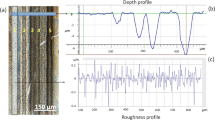Abstract
Owing to brittleness and hardness, optical glass is one of the materials that is most difficult to cut. Nevertheless, as the threshold value of the undeformed chip thickness is reached, brittle materials undergo a transition from the brittle to the ductile machining region. Below this threshold, it is believed that the energy required to propagate cracks is larger than the energy required for plastic deformation. Thus, plastic deformation is the predominant mechanism of material removal in machining these materials in this mode. An experimental study is conducted to diamond-cut BK7 glass in ductile mode. As an effective rake angle plays a more important role than a nominal rake angle does, a discussion about this effective angle is carried out in the paper. The investigation presents the feasibility of achieving nanometric surfaces. Power spectral density (PSD) analysis on the machined surfaces shows the difference between the characteristics of the two modes. During the experiments, it is recognised that tool wear is a severe problem. Further study is in process to improve the cutting tool life.









Similar content being viewed by others
References
Komanduri R, Lucca D A, Tani Y (1997) Technological advances in fine abrasive processes. Keynote Paper, Annals of CIRP 46(2):545–596
Venkatesh VC, Inasaki I, Toenshof HK, Nakagawa T, Marinescu ID (1995) Observations on polishing and ultra-precision machining of semi-conductor materials. Keynote Paper, Annals of CIRP, 44(2):611–618
Gee AE, Spragg RC, Puttick KE, Rudman MR (1991) Single-point diamond form-finishing of glass and other macroscopically brittle materials. SPIE 1573:39–48
Fang FZ, Venkatesh VC (1998) Diamond cutting of silicon with nanometric finish. Annals of CIRP 47(1):45–49
Shimada S, Inamura T, Takezawa N, Ohmori H, Sata T, Ikawa N (1995) Brittle-ductile transition phenomena in microindentation and micromachining. Annals of CIRP 44(1):523–526
Lucca DA, Brinksmeier E, Goch G (1998) Process in assessing surface and subsurface integrity. Annals of CIRP 47(2):669–694
Blackley WS, Scattergood RO (1991) Ductile regime model for diamond turning of brittle materials. Precis Eng 13(2):95–102
Jared BH, Dow TA (1997) Chip dynamics in diamond turning. Proc ASPE 16:230–233
Schinker MG, Doll W (1987) Turning of optical glass at room temperature. SPIE 802:70–80
Fang FZ, Chen L (2000) Ultra-precision cutting of ZKN7 glass. Annals of CIRP 49(1):17–20
Puttick KE, Rudman MR, Smith KJ, Franks A, Lindsey (1989) Single-point diamond machining of glass. Proc R Soc Lond A 426:19–30
Brehm R, Van Dun K, Teuunissen JCG, Haisma J (1979) Transparent single-point turning of optical glass. Precis Eng 1(3):207–213
Takeuchi Y, Sawada K, Sata T (1996) Ultra-precision 3-D micromachining of glass. Annals of CIRP 45(1):401–404
Moriwaki T, Shamoto E, Inoue K (1992) Ultra-precision ductile cutting of glass by applying ultrasonic vibration. Annals of CIRP 41(1):141–144
Schinker MG (1991) Subsurface damage mechanisms at high-speed ductile machining of optical glass. Precis Eng 13(3):208–218
Chiu W, Endres WJ, Thouless MD (2000) An experimental study of orthogonal machining of glass. Mach Sci Technol 4(2):253–275
Acknowledgements
The authors would like to thank Prof. Z. J. Yuan and Prof. V. C. Venkatesh for the discussions.
Author information
Authors and Affiliations
Corresponding author
Rights and permissions
About this article
Cite this article
Fang, F.Z., Zhang, G.X. An experimental study of optical glass machining. Int J Adv Manuf Technol 23, 155–160 (2004). https://doi.org/10.1007/s00170-003-1576-3
Received:
Accepted:
Published:
Issue Date:
DOI: https://doi.org/10.1007/s00170-003-1576-3




